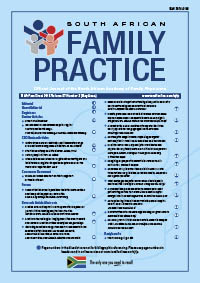Obesity prevalence and metabolic differences between obese and non-obese schoold adolescents in south-western Nigeria
Keywords:
adolescent, International Obesity Task Force (IOTF), obese, obesity, metabolic
Abstract
Background: Adolescent obesity is increasingly more common in low- and middle-income countries like Nigeria. Obesity has been associated with metabolic derangement in adolescents in developed countries. This study compared the metabolic parameters in obese and non-obese adolescents in a developing country. Method: A cross-sectional study was performed on 1 000 adolescents selected by multi-stage sampling from eight secondary schools in Osun State, south-western Nigeria. Socio-demographic information was collected with the aid of a questionnaire.Using the International Obesity Task Force (IOTF) body mass index (BMI) cut-off points, 29 obese adolescents were identified,and 29 suitably matched controls selected. The means for the anthropometric indices [height, weight and waist circumference (WC)], as well as blood pressure (BP), fasting blood glucose and the blood lipid levels of the obese and non-obese participants were compared using an independent t-test and one-way analysis of variance. Data were analysed using SPSS® 16.0 version. A p-value < 0.05 was taken to be statistically significant. Results: The mean age of the respondents was 13.7 years (standard deviation 2.04). Eight of 100 (7.7%) respondents were overweight and 2.9% obese. More female than male adolescents were overweight or obese. The means for the anthropometric indices and BP increased in general across the spectrum of weight categories, from normal weight to obese. Weight, BMI, WC, and systolic and diastolic blood pressure were significantly higher (p < 0.05) in the obese adolescents than in the non-obese controls. The controls had a significantly higher mean high-density lipoprotein value (1.46 mmol/l) than the obese adolescents (1.21 mmol/l). Conclusion: Obese adolescents are at higher risk of metabolic diseases than non-obese adolescents. Obese adolescents in low- to middle-income countries should be targeted to adopt lifestyle changes. (Full text available online at www.medpharm.tandfonline.com/ojfp) S Afr Fam Pract 2015; DOI: 10.1080/20786190.2014.977010
Published
2015-07-12
Section
Research Articles
By submitting manuscripts to SAFP, authors of original articles are assigning copyright to the South African Academy of Family Physicians. Copyright of review articles are assigned to the Publisher, Medpharm Publications (Pty) Ltd, unless otherwise specified. Authors may use their own work after publication without written permission, provided they acknowledge the original source. Individuals and academic institutions may freely copy and distribute articles published in SAFP for educational and research purposes without obtaining permission.

